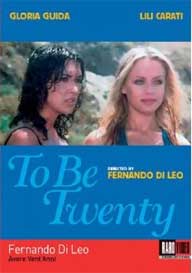 TO
BE TWENTY (1978)
TO
BE TWENTY (1978)Director: Fernando Di Leo
Raro Video USA
 TO
BE TWENTY (1978)
TO
BE TWENTY (1978)Two hitchhiking girls out for a little fun find terror (eventually) in Fernando Di Leo’s TO BE TWENTY (AVERE VENT’ANNI), one of Raro Video Italy’s popular slices of Eurosleaze cheese getting the remastered, special edition treatment from Raro’s American arm.

Lia (Gloria Guida, SO YOUNG, LOVELY, AND VICIOUS) and Tina (Lilli Carati, THE ALCOVE) meet on a beach and decide to hitch their way to Rome where Lia knows of a commune run by Nazariota (Vito Caprioli, TOUT VA BIEN). Upon arrival, Lia immediately takes an interest in commune life – helping out Patrizia (Daniela Doria, CITY OF THE LIVING DEAD), the single mother of triplets – while Tina just wants to get laid (only perpetually-tripping Rico [Raymond Lovelock, THE LIVING DEAD AT MANCHESTER MORGUE] interests her among the unwashed). Nazariota suggests that they contribute to the upkeep of the commune with their bodies. Tina is disgusted (she wants to get laid, but wants to be able to choose her partners), but Lia is okay with it as long as their partners are clean. When Tina tires “unfinished quickies” Nazariota sends them out to sell encyclopedias; of course, this is just another way of whoring themselves out. Following their radical appearance on a TV show called “Given the World to Women,” the commune is raided and planted drugs are used as an excuse to close it down. Lia and Tina are deported back to their home towns, but fate has something else in store for them at a roadside restaurant.
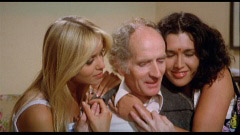 In
its original cut, TO BE TWENTY is a misanthropic film. The commune hippies are
unwashed and near comatose in their drugged state, Nazariota is more of a pimp
than a guru, lesbians hate all men and want to castrate them (and the men believe
those they perceive as lesbians just have not found the right man), the government
does not care about the communes unless they become political (then they’ll
plant talcum powder and conduct raids), and the middle class is full of perverted
hypocrites. Tina is “young, hot, and pissed off” because her parents
were raising her to be a housewife. She can do without sex, but she feels that
it is owed to her. Lia, on the other hand, is “young, hot” and only
a “little pissed off,” because she grew up an orphan and was molested
by one of her keepers. Tina is not above shaking her ass and offering blow-jobs
to distract and intimidate or to get freebies; although she plays the scandalized
woman when men are so forward. For most of the running time, Tina does not come
off well and would not be so sympathetic if it were not obvious that she cares
about the more passive Lia, and at no point does the viewer feel that Di Leo
is suggesting that they their fates. The rapists are the ones saying that the
two girls lead them on, and the voyeur (cameraman Roberto Reale, RULERS OF THE
CITY) is the most vile of them all (and perpetrates the most gruesome act).
Although the finale is grueling, it is perhaps more so for Guida’s performance
than what is actually shown in detail (the finale was shot day-for-night and
looks somewhat murky, although what is visible is still disturbing). Di Leo
knows “no means no” but he was apparently ahead of his time, because
the film was not well-received and it was hastily recut and reworked for an
Italian re-release, and this shorter and “fluffier” version became
the basis of the English-language version that has been most familiar to audiences
outside of Italy (and perhaps in Italy, since the film was apparently pretty
scarce in its original language before Raro Italy’s DVD edition).
In
its original cut, TO BE TWENTY is a misanthropic film. The commune hippies are
unwashed and near comatose in their drugged state, Nazariota is more of a pimp
than a guru, lesbians hate all men and want to castrate them (and the men believe
those they perceive as lesbians just have not found the right man), the government
does not care about the communes unless they become political (then they’ll
plant talcum powder and conduct raids), and the middle class is full of perverted
hypocrites. Tina is “young, hot, and pissed off” because her parents
were raising her to be a housewife. She can do without sex, but she feels that
it is owed to her. Lia, on the other hand, is “young, hot” and only
a “little pissed off,” because she grew up an orphan and was molested
by one of her keepers. Tina is not above shaking her ass and offering blow-jobs
to distract and intimidate or to get freebies; although she plays the scandalized
woman when men are so forward. For most of the running time, Tina does not come
off well and would not be so sympathetic if it were not obvious that she cares
about the more passive Lia, and at no point does the viewer feel that Di Leo
is suggesting that they their fates. The rapists are the ones saying that the
two girls lead them on, and the voyeur (cameraman Roberto Reale, RULERS OF THE
CITY) is the most vile of them all (and perpetrates the most gruesome act).
Although the finale is grueling, it is perhaps more so for Guida’s performance
than what is actually shown in detail (the finale was shot day-for-night and
looks somewhat murky, although what is visible is still disturbing). Di Leo
knows “no means no” but he was apparently ahead of his time, because
the film was not well-received and it was hastily recut and reworked for an
Italian re-release, and this shorter and “fluffier” version became
the basis of the English-language version that has been most familiar to audiences
outside of Italy (and perhaps in Italy, since the film was apparently pretty
scarce in its original language before Raro Italy’s DVD edition).

The tone of the recut is entirely different. Lia and Tina become Tina and Linda (and Nazariota becomes “Shining Ray”), and apparently have known each other for a while (their beach meeting in the original cut is entirely missing from this version). Patrizia is less philosophical about being saddled with triplets, Lia goes from being a sexually-abused orphan to a rich girl who seduced her teacher when she was 13, and Tina is “sick of sex for a while” after their near rape at the roadside café (here stopped by a long, sustained freeze frame and the sound of police sirens). Even though the gang rape and murder have been entirely cut from this version, the recut manages to be the misogynistic version. In the director’s cut, the documentary filmmaker (TORSO’s gawking delivery man Vincenzo Crocitti) states that the combination of Catholicism, Marxism, and psychoanalysis has created conditions conducive to schizophrenia. In the theatrical cut, he says all other theologies and theories of man have had their shortcomings exposed by a combination of Christian dogma, Marxism, and psychoanalysis. The performance piece “Scum” is reduced to “liberate your wombs, castrate the males” (the rest of the shots of the women reciting are intercut with the Tina/Rico sex scene and their voices are drowned out by music), and the TV show’s title is changed from “Giving the World to Women” to “The World of Women” (on channel 69). Whereas Shorty said in the Italian version that feminism is too complicated and they should leave it to women, as Curly he says that feminism is too complicated for the female mind. Scenes have also been shifted around and the finale closes with a chuckle (a scene originally about thirteen minutes into the original cut of the film), rather than a gut-punch. It is uncertain how much of this originated with the English dubbing script, and how much of the dialogue might have been rewritten for the Italian recut as part of the dumbing down of the original film by the producers.
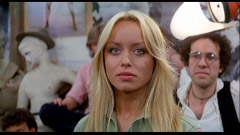 Raro’s
transfer of the “theatrical cut” on disc 2 is not technically the
film’s English language version. This is the aforementioned Italian recut
with the English track synchronized to it. The English prints (including the
Private Screenings VHS) began with the credits in a plain white font superimposed
over shots of the girls frolicking in the waves superimposed over still shots
of locations seen elsewhere in the film to a frenetic disco song (that song
can be heard on the English track replacing Ornella Vanoni’s catchy disco
song “Ti Voglio” in the scene where Carati gropes Lovelock in his
sleep). The theatrical cut on the Raro disc opens with the same hitchhiking
credits as seen on the original cut, again set to Guida’s theme song.
Although the transfer features Italian opening credits, it features the English
language closing credits crawl on black with the replaced theme song. The English
version of the shorter cut features dialogue and additional scenes by dubbing
regular Nick Alexander and British actor/dubbing artist Robert Booth (CONFESSIONS
OF A SUMMER CAMP COUNSELOR), and new CAM-licensed music “selected by”
Donatella Ibba (wife of composer Carlo Maria Cordio) replacing the Italian-language
pop songs (including Gloria Guida’s theme song). The English cut also
features a scene exclusive to this version – and likely shot by Nick Alexander
and Robert Booth – in which Lia and Tina first meet Shining Ray on the
road. In the Italian cut, we learn through dialogue that Lia first met Nazariota
in the Riviera six months before and that Tina has never met him before. The
English track improves on the original in its scoring of the foursome sex scene
with rock music, and the scoring of the “dancing in the streets”
scene (accompanied by the dreary theme song in the director’s cut).
Raro’s
transfer of the “theatrical cut” on disc 2 is not technically the
film’s English language version. This is the aforementioned Italian recut
with the English track synchronized to it. The English prints (including the
Private Screenings VHS) began with the credits in a plain white font superimposed
over shots of the girls frolicking in the waves superimposed over still shots
of locations seen elsewhere in the film to a frenetic disco song (that song
can be heard on the English track replacing Ornella Vanoni’s catchy disco
song “Ti Voglio” in the scene where Carati gropes Lovelock in his
sleep). The theatrical cut on the Raro disc opens with the same hitchhiking
credits as seen on the original cut, again set to Guida’s theme song.
Although the transfer features Italian opening credits, it features the English
language closing credits crawl on black with the replaced theme song. The English
version of the shorter cut features dialogue and additional scenes by dubbing
regular Nick Alexander and British actor/dubbing artist Robert Booth (CONFESSIONS
OF A SUMMER CAMP COUNSELOR), and new CAM-licensed music “selected by”
Donatella Ibba (wife of composer Carlo Maria Cordio) replacing the Italian-language
pop songs (including Gloria Guida’s theme song). The English cut also
features a scene exclusive to this version – and likely shot by Nick Alexander
and Robert Booth – in which Lia and Tina first meet Shining Ray on the
road. In the Italian cut, we learn through dialogue that Lia first met Nazariota
in the Riviera six months before and that Tina has never met him before. The
English track improves on the original in its scoring of the foursome sex scene
with rock music, and the scoring of the “dancing in the streets”
scene (accompanied by the dreary theme song in the director’s cut).
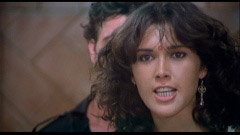
Carati got her start in early 1970s sex comedies Claudio de Molinis’ CANDIDO EROTICO and finished off her career in adult films in the late 1980s, but she is perhaps best known to international audiences for the handful of soft-core period films she made for Joe D’Amato, including THE ALCOVE and THE PLEASURE (both of which featured Laura Gemser). In TO BE TWENTY, she demonstrates some affinity for comedy (for instance, the scene in which she pretends to be turned on by “culture” to sell encyclopedias to a horny old professor [Danielle Vargas, EYEBALL]). A former Miss Teenage Italia, Guida also started out in sex comedies like Mario Imperioli’s BLUE JEANS, but had a more varied career with roles in gialli like Giuseppe Rosati’s THE PERFECT CRIME and Silvio Amadio’s psychological drama SO YOUNG, LOVELY, AND VICIOUS, but most grindhouse viewers probably saw her in Rene Cardona’s supernaturally-themed THE BERMUDA TRIANGLE with John Huston and Claudine Auger. In 1991, she married actor/composer/singer Johnny Dorelli and left the film business. For much of the film, she wears a neutral expression, but this is justified in her “why are you so angry” monologue in reaction to Tina’s on-camera rant about her parents. Lovelock had previously appeared in Ruggero Deodato’s LIVE LIKE A COP, DIE LIKE A MAN, which was scripted by Di Leo. He doesn’t have much to do here as he’s unconscious for most of his screentime (the better to be groped by Lilli Carati). Caprioli had previously appeared in five other Di Leo films, including THE ITALIAN CONNECTION and RULERS OF THE CITY, as his role is a combination of comic relief and sleaze. Leopoldo Mastelloni (the scheming butler of Dario Argento’s INFERNO) plays a pacifist human statue, meditating in service of the supreme creator, Fernando Cerulli (the bathtub victim of WATCH ME WHEN I KILL) is a horny widower, and Sergio Di Pinto (the original SCENT OF A WOMAN) provides comic relief as Shorty (Curly in the English version). Radio actor Giorgio Bracardi (BANANA JOE) is a standout as the volatile police lieutenant. The score of Franco Campanino (AMAZONIA) is largely overshadowed by the other songs on the Italian version, and is entirely absent from the English track (although I’m not sure if it is present on the Italian track for the recut). Di Leo’s regular set designer Francesco Cuppini (THE FRIGHTENED WOMAN) dresses up the commune walls with a mural collage of graffiti and images of Marx and John F. Kennedy, but really gets to show off his pop-art style in home of the desperate housewife who tries to seduce encyclopedia-selling Lia. Cinematographer Roberto Gerardi (HONOR AMONG THIEVES) shot six films for Di Leo, including NICK THE STING, and his last two films THE VIOLENT BREED, and KILLER VS KILLERS.
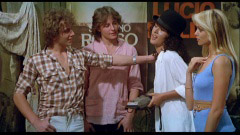 AVERE
VENT’ANNI was first released on DVD by Trash Mountain Video in Japan in
a fullscreen (likely optically-fogged), Japanese-subtitled transfer of the Italian
version, and then as an unauthorized Alfa Digital two-disc set featuring the
Italian and English versions, letterboxed but from inferior sources, exclusive
– though brief – interviews with Di Leo and Lovelock, and a Gloria
Guida photo gallery scored with a track from Ennio Morricone’s score for
THE BIRD WITH THE CRYSTAL PLUMAGE. Raro Italy’s 2-disc edition soon followed
with 16:9 transfers of the original cut and the theatrical cut (including English
subtitles for the longer cut and English and Italian tracks for the shorter),
as well as a featurette with Di Leo and Lovelock. Raro USA’s edition has
carried over the two cuts and the featurette. Raro’s progressive, anamorphic
1.85:1 transfer of the director’s cut (97:33) is the lesser of the two
versions quality wise. The image is clean but colors are duller, the contrasts
weaker, and only fair detail (the finale will always look murky in this version
since it is a day-for-night shoot). Green vertical scratches pop up every one
in a while. The Italian mono track sounds good with the music coming through
nicely and I noted no faults in the English subtitling. The first pressing was
apparently faulty with the film returning to the main menu at the end of chapter
ten, but my disc played through to the end. Sharing disc 1 is the documentary
“Twenty Years for a Massacre” (29:46). Fernando Di Leo talks about
charges of hypocrisy and misogyny, and says the recut version makes no sense
because it is the story of two girls who think they are free getting killed
for being free. He partially blames the audience who idolized Guida and Carrati
finding their onscreen treatment disagreeable, but also says perhaps his script
was a bit frivolous. Mastelloni refers to the project as a “beautiful,
significant, but bitter film, and recalls that the foursome sex scene was shot
with non-professional actors, and a lot of cold water was needed to… well,
you know. Lovelock recalls working primarily with Carati, and admiring Caprioli
and Bracardi. Bracardi is not too impressed with his “cinematic venture.”
Gianluca Curti, the son of the producer, recalls the recutting of the film –
the negative was cut to assemble to new version, which explains the lesser condition
of the director’s cut – and the changes he made to the Italian video
version of the theatrical cut in the mid-1980s (two scenes were redubbed so
that the dialogue matched the English versions of the two scenes, suggesting
that the original dialogue of these scenes was not amended at the time of the
re-editing). The English language credit sequence is shown in excerpt with a
black background, rather than the moving one of the English prints. The clips
are sometimes overlong – the scene where Tina gropes Rico in his sleep
is shown in its entirely – and seem to come from a very worn VHS. The
subtitling of the interview is error-free, but several lines are left untranslated
whenever the name and role of one of the interviewees comes up onscreen (the
subtitlers apparently think we would rather know that “attore” means
actor than understand their opening remarks). It is an informative piece, but
not as well-constructed as Raro’s other documentaries. Disc 2 of the Raro
USA release features the theatrical version (83:42) in a single-layer, progressive,
anamorphic transfer that is generally in nicer condition compared to the director’s
cut with finer detail and brighter colors. I noted no problems with the English
mono track. The U.S. edition also features a liner notes booklet by Nathaniel
Thompson, filmographies, and a photo gallery (the extras cite the original screenplay
as an extra, but I could not find it in the disc menus or as a DVD-ROM supplement).
(Eric
Cotenas)
AVERE
VENT’ANNI was first released on DVD by Trash Mountain Video in Japan in
a fullscreen (likely optically-fogged), Japanese-subtitled transfer of the Italian
version, and then as an unauthorized Alfa Digital two-disc set featuring the
Italian and English versions, letterboxed but from inferior sources, exclusive
– though brief – interviews with Di Leo and Lovelock, and a Gloria
Guida photo gallery scored with a track from Ennio Morricone’s score for
THE BIRD WITH THE CRYSTAL PLUMAGE. Raro Italy’s 2-disc edition soon followed
with 16:9 transfers of the original cut and the theatrical cut (including English
subtitles for the longer cut and English and Italian tracks for the shorter),
as well as a featurette with Di Leo and Lovelock. Raro USA’s edition has
carried over the two cuts and the featurette. Raro’s progressive, anamorphic
1.85:1 transfer of the director’s cut (97:33) is the lesser of the two
versions quality wise. The image is clean but colors are duller, the contrasts
weaker, and only fair detail (the finale will always look murky in this version
since it is a day-for-night shoot). Green vertical scratches pop up every one
in a while. The Italian mono track sounds good with the music coming through
nicely and I noted no faults in the English subtitling. The first pressing was
apparently faulty with the film returning to the main menu at the end of chapter
ten, but my disc played through to the end. Sharing disc 1 is the documentary
“Twenty Years for a Massacre” (29:46). Fernando Di Leo talks about
charges of hypocrisy and misogyny, and says the recut version makes no sense
because it is the story of two girls who think they are free getting killed
for being free. He partially blames the audience who idolized Guida and Carrati
finding their onscreen treatment disagreeable, but also says perhaps his script
was a bit frivolous. Mastelloni refers to the project as a “beautiful,
significant, but bitter film, and recalls that the foursome sex scene was shot
with non-professional actors, and a lot of cold water was needed to… well,
you know. Lovelock recalls working primarily with Carati, and admiring Caprioli
and Bracardi. Bracardi is not too impressed with his “cinematic venture.”
Gianluca Curti, the son of the producer, recalls the recutting of the film –
the negative was cut to assemble to new version, which explains the lesser condition
of the director’s cut – and the changes he made to the Italian video
version of the theatrical cut in the mid-1980s (two scenes were redubbed so
that the dialogue matched the English versions of the two scenes, suggesting
that the original dialogue of these scenes was not amended at the time of the
re-editing). The English language credit sequence is shown in excerpt with a
black background, rather than the moving one of the English prints. The clips
are sometimes overlong – the scene where Tina gropes Rico in his sleep
is shown in its entirely – and seem to come from a very worn VHS. The
subtitling of the interview is error-free, but several lines are left untranslated
whenever the name and role of one of the interviewees comes up onscreen (the
subtitlers apparently think we would rather know that “attore” means
actor than understand their opening remarks). It is an informative piece, but
not as well-constructed as Raro’s other documentaries. Disc 2 of the Raro
USA release features the theatrical version (83:42) in a single-layer, progressive,
anamorphic transfer that is generally in nicer condition compared to the director’s
cut with finer detail and brighter colors. I noted no problems with the English
mono track. The U.S. edition also features a liner notes booklet by Nathaniel
Thompson, filmographies, and a photo gallery (the extras cite the original screenplay
as an extra, but I could not find it in the disc menus or as a DVD-ROM supplement).
(Eric
Cotenas)